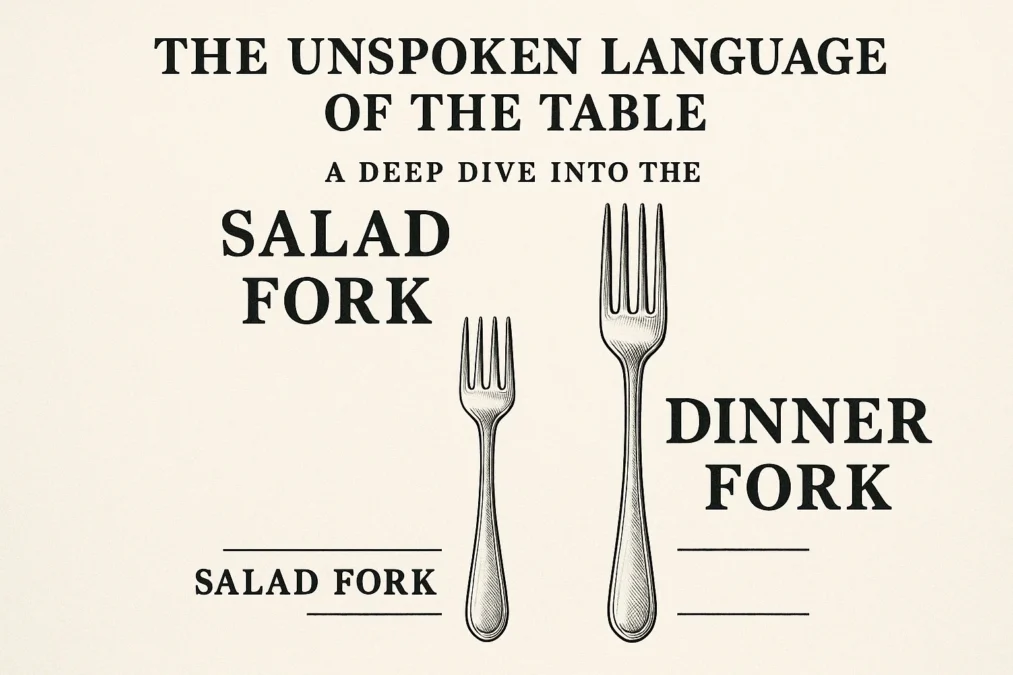In the elegant symphony of a formal place setting, the array of silverware can feel like a silent, intimidating test. A battalion of forks, spoons, and knives gleams back at you, each with a seemingly secret purpose. Among them, the forks often cause the most confusion. Why are there two, three, or sometimes even four? The most common pairing, and the one that forms the foundation of Western dining etiquette, is the classic duo: the salad fork and the dinner fork. At first glance, they might look nearly identical, but to the trained eye—and for the culturally savvy diner—the differences are clear and meaningful.
Understanding the distinction between a salad fork and a dinner fork is about more than just avoiding a social faux pas. It’s an entry point into the fascinating world of dining traditions, functional design, and the subtle ways we navigate shared meals. This isn’t just about following arbitrary rules; it’s about appreciating how form follows function in even the most mundane objects. Why does one fork have a thicker tine? Why is the other often smaller? The answers lie in the nature of the food they are designed to eat. In this comprehensive guide, we will dissect every aspect of the salad fork vs dinner fork debate. We will explore their unique histories, their distinct physical characteristics, their proper placement on the table, and how modern dining has reshaped these age-old conventions. By the end, you will not only know which fork to use and when, but you will also understand the why behind it all, transforming a moment of uncertainty into one of confident ease.
Setting the Table: A Tale of Two Forks
Before we can compare them side-by-side, we need to understand their individual roles. The dinner fork, often called the place fork, is the workhorse of the place setting. It is the primary utensil for the main course, designed to handle the heartiest parts of the meal—be it a perfectly cooked steak, a piece of roasted chicken, or a serving of pasta. Its design is one of robustness and versatility, meant to spear, lift, and support a wide variety of textures and weights. In many ways, the dinner fork is the default, the standard against which other specialized forks are measured.
The salad fork, on the other hand, is a specialist. It is crafted with the specific demands of a green salad in mind. Traditionally, a salad was served after the main course in a fine dining setting, a practice still common in many European countries. This was intended to refresh the palate before cheese or dessert. The salad fork, therefore, had to be designed for the delicate, often slippery nature of lettuce leaves, vegetables, and vinaigrettes. Its entire being—from its size to the shape of its tines—is a response to this particular culinary challenge. The coexistence of these two forks on the same table speaks to a structured progression of a meal, where each course is given its own dedicated tool.
The Anatomy of a Fork: A Detailed Physical Comparison
The most straightforward way to tell a salad fork apart from a dinner fork is to examine its physical attributes. While there can be variations in design, especially with modern and artistic flatware, traditional patterns adhere to a set of common distinctions.
Size and Stature: The Most Noticeable Difference
The dinner fork is typically the longest fork in a standard place setting, measuring usually around 7 to 8 inches in length. This larger size provides leverage and stability when cutting against a knife and lifting heavier, more substantial pieces of food. It feels substantial in the hand, a tool built for a primary task. The salad fork is almost always shorter, generally coming in at around 6 to 7 inches long. Its smaller stature makes it more maneuverable for tossing and eating a lighter, more voluminous course. It’s designed for precision, not power, allowing you to easily navigate a bowl of mixed greens.
The Tale of the Tines: Shape, Count, and Function
This is where the functional design truly shines. A classic dinner fork features four long, straight, and evenly spaced tines. The tips are sharp enough to pierce food but the overall design is balanced for both spearing and scooping. The tines are robust to withstand the pressure of cutting. The salad fork also usually has four tines, but here is where a key differentiator often appears. On many traditional salad forks, the leftmost tine is noticeably wider and thicker than the others. This reinforced tine is designed specifically for cutting. Since you would not use a knife to cut salad greens (it would bruise them and be impractical), this sturdy tine allows you to press down with it to cut through a stubborn piece of lettuce or a larger vegetable chunk.
Furthermore, some salad forks may have tines that are slightly curved or have a broader, flatter profile, almost spoon-like, to better accommodate loose dressings and smaller items like kernels of corn or beans. The dinner fork’s tines are purely for piercing and holding, while the salad fork’s tines are often multi-functional, incorporating a cutting capability. As a renowned etiquette expert, Letitia Baldrige, once noted, “The utensils are your silent servants; they are there to make the meal easier, not harder. Understanding their design is the first step to using them gracefully.”
Weight and Feel in the Hand
Heft is another distinguishing factor. A dinner fork, being larger and designed for more strenuous work, is generally heavier and has a more substantial feel. The handle might be thicker to provide a secure grip during cutting. A salad fork is lighter and more delicate. Picking them up, one after the other, you would immediately feel the difference—the dinner fork communicates its role as a primary tool, while the salad fork feels like a precision instrument for a secondary, more delicate course.
The Placement on the Table: A Map of the Meal
In formal table setting etiquette, known as cover setting, the placement of the forks is not random. It follows the “outside-in” rule, which provides a logical and intuitive guide for the diner. Forks are always placed to the left of the dinner plate.
The dinner fork, being used for the main course, is placed closest to the plate. It is the innermost fork on the left side. The salad fork, if the salad is served after the main course as is traditional, is placed to the left of the dinner fork. This is because you use the utensils for the first course first, working your way from the outside in. So, if your salad is your first course, you would use the fork farthest to the left. However, in the American style of dining, where the salad is often served before the main course, the placement remains the same, but the intended order changes. You would still pick up the outermost fork (the salad fork) to eat your salad.
If a third fork is present, such as a fish fork, it would be placed to the left of the salad fork. This consistent system ensures that even at the most elaborate dinners, a diner is never truly lost; the table itself provides the instructions. The silent conversation between the salad fork and dinner fork, separated by a few inches of tablecloth, tells the entire story of the meal’s intended progression.
The Historical Journey of the Specialized Fork
To truly appreciate why we have two different forks, we must take a step back in time. The fork itself is a relatively late addition to the Western dining table. While versions of the fork existed in ancient Egypt and the Byzantine Empire, it was viewed with suspicion in much of Europe for centuries, where food was predominantly eaten with knives, spoons, and fingers. It was in Italy in the 11th century that the fork began to gain traction, slowly spreading to France and England through royal marriages.
Initially, there was just one fork, a personal, often ornate two-tined implement used primarily for spearing food from a shared platter. As dining became more refined and courses were served sequentially rather than all at once, the need for specialized utensils grew. The 18th and 19th centuries, particularly in the Victorian era, saw an explosion in the variety of flatware. This was a period of immense social change where displaying one’s wealth and knowledge of etiquette became paramount. Having a different fork for salad, fish, dessert, and oysters was a clear status symbol.
The salad fork emerged as a distinct entity during this time. The practice of eating raw greens with a dressing, which dates back to Roman times, evolved into the composed salads we know today. The culinary need for a utensil that could handle these delicate, dressed greens without being cumbersome led to the design innovations we see in the reinforced tine and smaller size. The dinner fork solidified its role as the primary utensil, evolving from a larger, general-purpose fork. This historical context shows that the distinction between a salad fork and a dinner fork is not a modern invention but the result of centuries of culinary and social evolution.
Modern Dining: When the Rules Bend and Blur
In today’s world of fast-casual dining, food trucks, and multicultural fusion cuisine, the rigid rules of formal table setting have inevitably relaxed. For most everyday meals at home or in a casual restaurant, the multipurpose dinner fork reigns supreme. It is perfectly acceptable, and often expected, to use your one fork for everything from your appetizer to your main course. The concept of a separate salad fork is largely reserved for fine-dining establishments, very formal dinners, and traditional households.
This shift reflects a broader trend towards practicality and informality. Many modern flatware sets are designed with this in mind, often featuring a “luncheon” or “all-purpose” fork that splits the difference between the traditional dinner and salad fork in size. Furthermore, the order of courses has become more fluid. With the salad now commonly served as a starter, the functional need for a separate, specialized fork has diminished for many people. You can certainly use your dinner fork to eat a salad; it will get the job done, even if it’s not the ideal tool from a purist’s perspective.
However, this does not mean that the knowledge is obsolete. Understanding the difference between a salad fork and a dinner fork remains a valuable skill. It demonstrates cultural literacy and respect for the host at a formal event. It can enhance your experience at a high-end restaurant, allowing you to appreciate the thoughtfulness behind every detail of the service. In a world where casual is king, knowing the formal rules gives you the confidence to navigate any dining situation, from a backyard barbecue to a state dinner.
Choosing the Right Fork for Your Table
When you are purchasing flatware for your home, the decision of whether to have dedicated salad forks or to rely on a multipurpose set is a personal one, guided by your lifestyle and entertaining habits.
For those who host frequent dinner parties or enjoy setting a formal table, a complete set with both dinner forks and salad forks is a wonderful investment. It allows you to create a traditional, elegant table setting that shows care and attention to detail for your guests. Look for sets where the design distinctions are clear, making it easy for your guests to identify which utensil is which. If your life is more casual and your meals are typically single-course affairs or eaten family-style, a beautiful set of all-purpose forks will serve you perfectly well. Many contemporary designers create versatile forks that are slightly smaller than a traditional dinner fork but sturdier than a salad fork, offering the best of both worlds.
Grille vs Grill: The Sizzling Guide to Spelling, Meaning, and Usage
Consider also the material and style. Stainless steel is durable and practical, while sterling silver requires more care but offers unparalleled classic beauty. The choice between a salad fork and a dinner fork in your own home is less about strict etiquette and more about the kind of dining experience you wish to cultivate. As the celebrated chef Julia Child aptly put it, “The enjoyment of a well-set table is part of the enjoyment of the meal itself. It’s the first taste you have of what’s to come.”
Beyond the Basics: Other Forks in the Family
Once you have mastered the salad fork vs dinner fork dynamic, you can appreciate the entire ecosystem of specialized forks. Each has a unique design tailored to its specific food.
The fish fork is shorter than a dinner fork and often has a wider, flatter design with a notch on the side, sometimes used to separate fish bones. The dessert fork, or pastry fork, is typically even smaller than a salad fork and may have a wider left tine, not for cutting, but for being a combination fork and spoon, sometimes even having a curved design. The oyster fork is the smallest of all, with three short, stout tines, and is the only fork placed on the right side of the setting, alongside the knives and spoons. Understanding the salad fork and dinner fork provides the foundational knowledge to identify and understand the purpose of these other members of the fork family.
A Global Perspective on Fork Etiquette
It’s important to remember that the specific rules governing the salad fork and dinner fork are primarily a feature of Western, and particularly American and European, formal dining. Table manners vary dramatically around the world. In many Asian cultures, chopsticks are the primary utensil, and the fork is used sparingly, if at all. In parts of Africa and the Middle East, eating with the right hand is the traditional and respectful custom.
Even within Europe, there are variations. In the UK, the fork is often held tines-down in the left hand for cutting and eating, a style known as the “European” or “Continental” style. In the American style, the fork is switched between the left and right hands after cutting. The placement of the salad fork can also hint at the order of courses based on whether the host is following American or European traditions. This global context reminds us that while the details of the salad fork and dinner fork are interesting, they are just one part of a rich and diverse tapestry of global dining customs.
The Practical Benefits of Using the Right Fork
While it may seem like a trivial matter of etiquette, using the correct fork—a salad fork for salad and a dinner fork for the main course—does offer subtle practical advantages that enhance the dining experience.
The smaller, often wider-tined salad fork is genuinely better at handling leafy greens. Its size makes it less likely to bruise delicate lettuce, and its design helps to cradle dressing-coated ingredients, preventing them from sliding off. Trying to eat a simple green salad with a large dinner fork can be a clumsy experience, often resulting in oversized bites or food falling off the tines. Conversely, using a delicate salad fork to tackle a piece of steak would be frustrating and ineffective; the fork may not pierce the meat cleanly, and it lacks the heft to provide a stable counterpoint for your knife. The right tool truly does make the job easier and more enjoyable.
This principle of specialized design is evident throughout the kitchen. We have different knives for bread, paring, and carving. We have slotted spoons for draining and teaspoons for stirring. The distinction between a salad fork and a dinner fork is simply an extension of this logical approach to tools. By using each fork for its intended purpose, you are not just following a rule; you are optimizing your meal for comfort, efficiency, and pleasure.
Common Confusions and How to Avoid Them
Even with a clear understanding of the differences, it’s easy to feel a moment of panic when faced with a complex table setting. Here are some common points of confusion and simple ways to navigate them.
One frequent question is what to do if you accidentally use the wrong fork. The simple answer is: don’t panic. Etiquette is ultimately about making others feel comfortable, and drawing attention to a minor mistake causes more discomfort than the mistake itself. If you realize you’ve used your dinner fork for your salad, quietly keep it. A good server will often replace it between courses, giving you a fresh start. If they don’t, you can continue with the same fork; it’s not a cardinal sin. Another confusion arises when the flatware set is non-traditional, with forks that don’t follow the classic size or tine design. In this case, always fall back on the “outside-in” rule. The fork placed on the far left is for the first course, whatever that may be.
Remember, the ultimate goal of all dining etiquette is to allow you and your fellow diners to relax and enjoy the food and conversation. Knowing the difference between a salad fork and a dinner fork is a tool to achieve that comfort, not a barrier to it. If you are ever in doubt, observe your host or the most experienced diner at the table. A confident, calm demeanor is the best utensil you can bring to any meal.
Comparison Table: Salad Fork vs Dinner Fork
| Feature | Salad Fork | Dinner Fork |
|---|---|---|
| Primary Use | Eating salad, often as a separate course. | Eating the main course (entrée). |
| Typical Length | Shorter (approx. 6-7 inches). | Longer (approx. 7-8 inches). |
| Tine Design | Often has a wider, reinforced outer left tine for cutting. Sometimes slightly curved or flatter. | Four uniform, straight, and robust tines. |
| Weight & Heft | Lighter and more delicate. | Heavier and more substantial. |
| Table Placement | Placed to the left of the dinner fork (the outermost left fork if salad is first). | Placed directly to the left of the plate (the innermost left fork). |
| Ideal For | Handling delicate, leafy greens and vegetables with dressing. | Piercing and holding heavier foods like meat, pasta, and potatoes. |
Frequently Asked Questions
What is the most noticeable physical difference between a salad fork and a dinner fork?
The most immediate and noticeable difference is the size. The dinner fork is almost always longer and larger than the salad fork. Upon closer inspection, you will often find that the salad fork has a unique feature: the leftmost tine is typically thicker and wider, sometimes with a slight notch, which is specifically designed to help you cut through salad greens without needing a knife.
Can I just use a dinner fork for my salad if I don’t have a dedicated salad fork?
Absolutely. In casual, everyday dining, using a dinner fork for your salad is completely acceptable and very common. The dinner fork is a versatile tool. While a dedicated salad fork might offer a slightly better experience for handling leafy greens and dressings, the dinner fork will get the job done perfectly well. The rules of formal table setting are guidelines for specific contexts, not strict laws for every meal.
Why is the salad fork sometimes placed on the outside and sometimes on the inside?
The placement depends on the order of the meal. The universal rule is “outside-in,” meaning you use the utensils farthest from the plate first. In the American style, where salad is typically served as a first course, the salad fork is placed on the far left (the outside). In the traditional European style, where salad is often served after the main course to cleanse the palate, the salad fork would be placed between the plate and the dinner fork (on the inside). The table setting is a map of the meal to come.
I’ve seen forks with three tines. Is that a salad fork or a dinner fork?
While four tines are standard for both dinner and salad forks, three-tined forks do exist and have a historical precedent. In the past, many dinner forks had only three tines. Today, a three-tined fork is more likely to be a specialized fork, such as a seafood fork for lobster or crab, or a vintage piece. You would identify it based on its size and placement rather than just the tine count. A large three-tined fork is likely a dinner fork, while a small one could be for dessert or seafood.
Is the knowledge of salad fork vs dinner fork still relevant today?
Yes, but its relevance is context-dependent. For most daily meals, it is not a critical concern. However, this knowledge remains highly relevant for formal occasions, business dinners, fine-dining restaurants, and any situation where demonstrating cultural and social literacy is valued. Understanding the difference gives you confidence, prevents anxiety, and allows you to focus on enjoying the company and the conversation rather than worrying about your utensils. It’s a piece of social knowledge that, when needed, is invaluable.
Conclusion
The journey into the world of the salad fork vs dinner fork reveals a story far richer than a simple comparison of two utensils. It is a narrative woven from threads of history, functional design, social custom, and practical etiquette. What begins as a question of “which fork do I use?” unfolds into an appreciation for the thoughtful ways humans have designed rituals around the fundamental act of sharing a meal. The robust, versatile dinner fork, built for the main event, stands in perfect contrast to the nimble, specialized salad fork, engineered for the delicate task of handling greens.
In our modern, often informal world, this knowledge is not about elitism or creating barriers. On the contrary, it is about empowerment. It is about having the confidence to walk into any dining situation, from the most casual to the most formal, and feel at ease. It is about understanding that these tools were created to make our experience better, and that knowing how to use them is a form of respect—for the food, for the host, and for the shared tradition of the table. So the next time you sit down to a set table, you can look at the forks not with confusion, but with recognition. You will see the logical placement, the thoughtful design, and the unspoken language of a meal about to be enjoyed.



